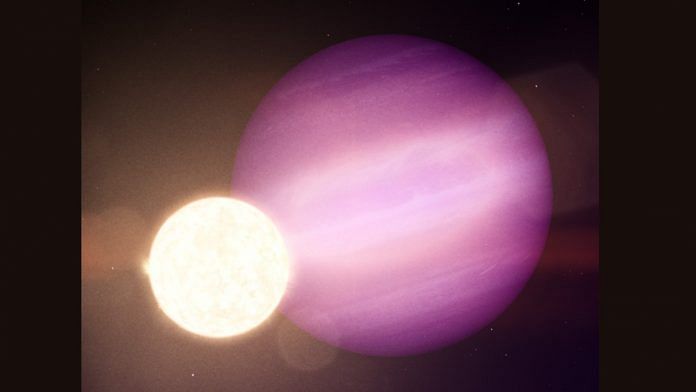Bengaluru: For the first time ever, astronomers have detected a planet in orbit around a dead star.
According to findings published in the journal Nature Wednesday, a planet the size of Jupiter is in orbit around a white dwarf — the remnant after a star’s death — which is 80 light years away from Earth. The planet takes merely 1.4 days to complete one orbit.
Earlier it was thought that planets could not form around a white dwarf due to the violent nature of the white dwarf formation.
However, this study supports the theory that massive planets can survive the creation of a white dwarf, migrate close to it and then resume orbit around the new remnant.
The observations were made using NASA’s Transiting Exoplanet Survey Satellite (TESS) and retired Spitzer Space Telescope.
The findings have implications for the survival of other kinds of planets during the death of a star, including Earth-like rocky planets.
In an independent paper, published in the journal The Astrophysical Journal Letters, astronomers also theorised what the habitable zone could be like for an Earth-like planet around this white dwarf.
Also read: Scientists discover three stars ripping apart their planet-forming disc
Surviving the migration
The findings were made around the white dwarf named WD 1856+534, which is part of a three-star system.
The Jupiter-sized exoplanet candidate, named WD 1856b, is about seven times larger in size than the white dwarf. It is thought to be about 14 times the mass of Jupiter and goes around the star every 34 hours — over 60 times faster than the time Mercury takes to orbit the sun.
It has been theorised that 15 per cent of white dwarfs should have orbiting planets or planetary cores.
To do so, planets that existed around the erstwhile star must migrate inwards towards what is now the white dwarf and settle into a stable orbit. However, the space around a white dwarf is filled with expelled matter so it was thought that an existing planet could not possibly survive the journey.
“WD 1856 b somehow got very close to its white dwarf and managed to stay in one piece,” said Andrew Vanderburg, lead author and assistant professor of astronomy at the University of Wisconsin-Madison in a statement.
“The white dwarf creation process destroys nearby planets, and anything that later gets too close is usually torn apart by the star’s immense gravity. We still have many questions about how WD 1856 b arrived at its current location without meeting one of those fates,” said Vanderburg.
“This is the first planet we’ve observed to have survived its migratory journey intact,” he added.
Scientists think that the planet must have originally been at least 50 times farther from its present location.
WD 1856b is still a candidate planet and awaits further analysis. No other planets have been detected around WD 1856.
Also read: Indian physicist discovers bacterium-sized deformity in neutron star 4,500 light years away
Red giant to white dwarf
Stars that are up to 10 times the mass of our sun have a typical life cycle, where they first evolve into expanding but cooling red giants and then shrink down to white dwarfs. About 97 per cent of stars in the Milky Way will eventually become white dwarfs in their final evolutionary state.
White dwarfs are formed when the star exhausts its nuclear fuel and towards the end of the fuel burning stage, expels its outer layers to form a planetary nebula around the core. A planetary nebula is a shell of gas that is ejected from stars.
They do this by shedding up to 80 per cent of their original mass, which then incinerates everything nearby.
The process of a white dwarf formation is extremely energetic but is slow and lasts years. This is unlike a supernova that more massive stars undergo, to form a neutron star or black hole, which occurs in a matter of minutes.
The remaining hot core of the original star is the white dwarf.
White dwarfs’ mass are about half as much as the sun but they are only slightly bigger than the Earth in size. Only neutron stars and black holes, the other two ‘compact objects’ formed after the death of a star, are denser than them.
Unlike stars, the white dwarf is prevented from collapsing into itself under the weight of its gravity because inside a compact object, there is no more space, as even electrons that cannot stay together are squished together to occupy close spaces.
White dwarfs do not have any fuel and don’t burn energy, but are sources of X-rays. Upon formation, the white dwarf is hotter than 100,000 K (or almost 100,000 degrees celsius), but it cools over the next billions of years.
They eventually stop emitting radiation, becoming a black dwarf. No black dwarfs exist yet as the universe is younger than the time it takes to form a black dwarf.
The nearest known white dwarf is Sirius B, one of the two stars that make up the Sirius binary star system. It is located 8.6 light years away.
Also read: A dancing star in the heart of the Milky Way proves Einstein right, again



